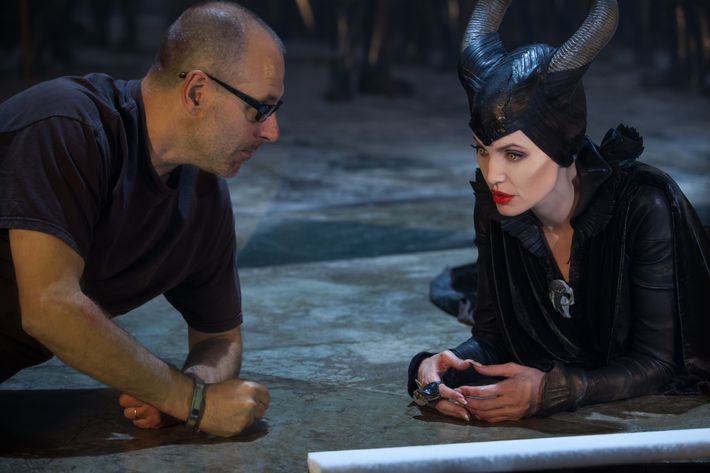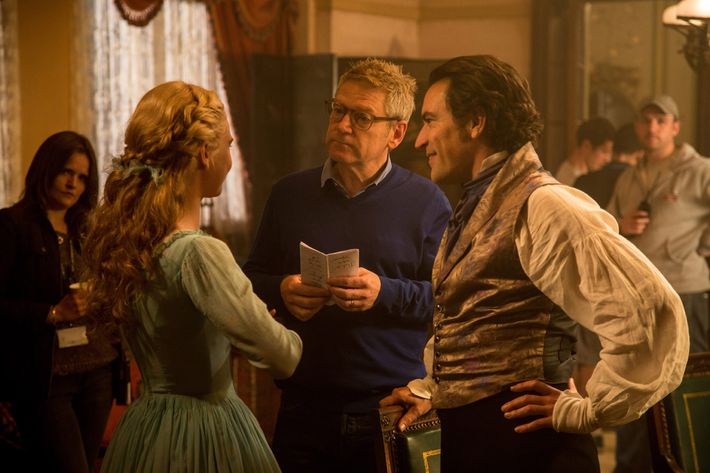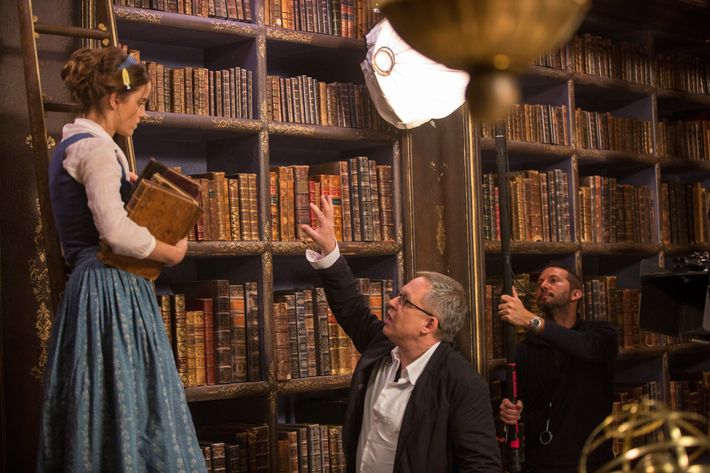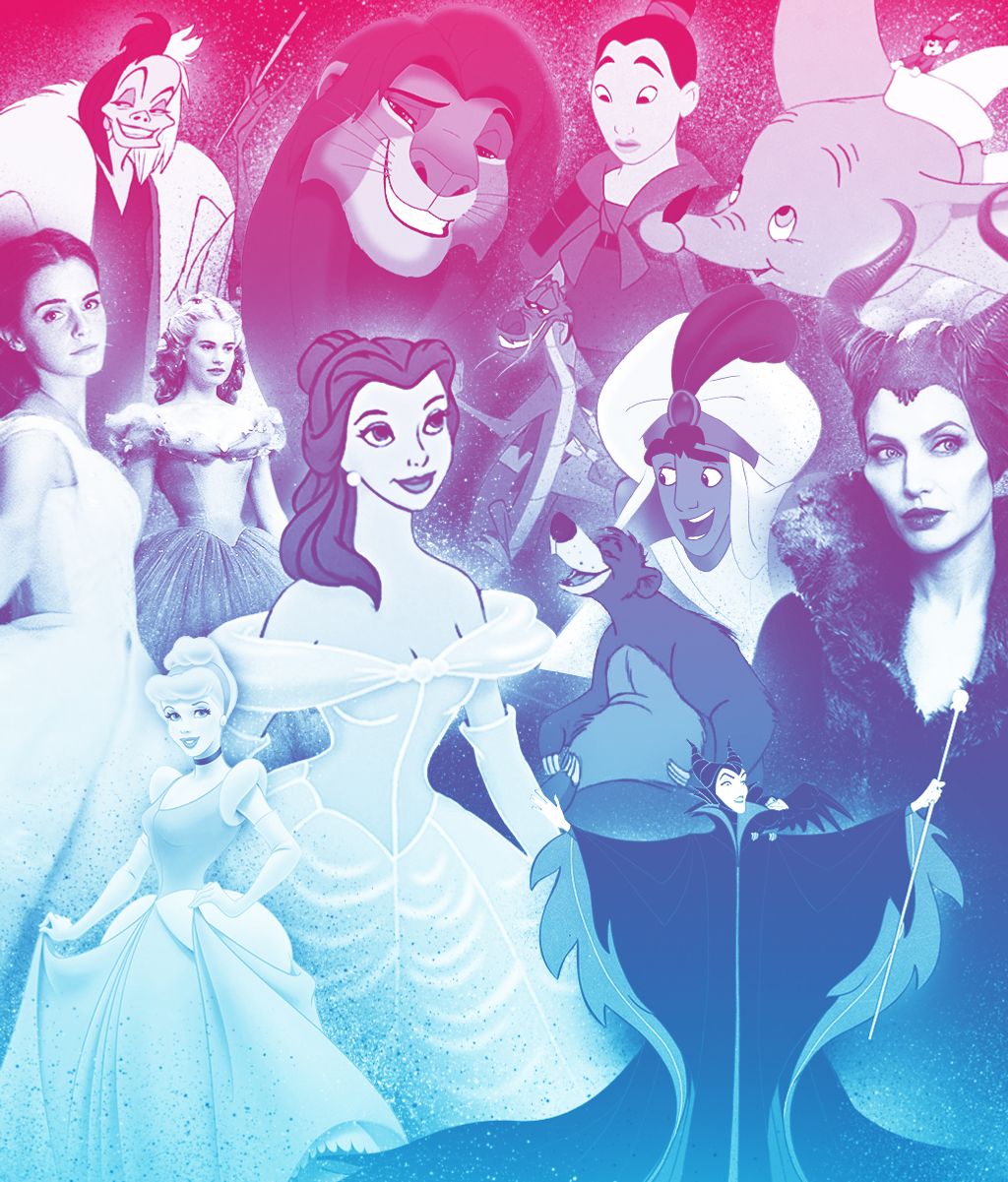Back in 2007, Tim Burton made a splashy homecoming. The director had spent the early part of his career working on short films for Disney and animating on now-forgotten projects like The Fox and the Hound; now he was returning to the studio to develop a pair of ambitious remakes, one of his short film Frankenweenie and the other a live-action remake of the animated Alice in Wonderland. The reason that Disney had been so keen to lure the director back had mostly to do with product. In the years since Burton’s The Nightmare Before Christmas was released in 1993, the demand for its merchandise had only increased; a movie that was initially seen as a commercial disappointment was generating millions of dollars a year. If the same logic held, Burton would be able to turn these older properties into something fresh, fun, and highly sellable.
It worked. Alice in Wonderland, eventually released in spring 2010, wound up making more than $1 billion worldwide. Its success proved to Disney that remaking its animated classics wasn’t just potentially lucrative, but could be a core element of the company’s strategy. Now the company is through the looking glass: The years since Alice have brought Maleficent, based on Sleeping Beauty, but told from the point of view of the self-described “Mistress of Evil”; Kenneth Branagh’s gorgeous Cinderella; and Jon Favreau’s The Jungle Book, which just won an Oscar for Best Visual Effects. (Favreau is currently mounting a new, hyperreal version of The Lion King, with Donald Glover as Simba and James Earl Jones returning as Mufasa.) Alongside these four hits have been two disappointments: the Alice sequel and the remake of Pete’s Dragon (which may not exactly count, since the original was an animation–live-action hybrid).
Which brings us to this weekend’s Beauty and the Beast, a remake of one of the most beloved animated films ever. With massive prerelease buzz and advance ticket sales, it seems primed become Disney’s biggest remake yet. And there’s nobody who has been more firmly entrenched in this new world of animated to live-action remakes than Sean Bailey, the president of Motion Picture Production at Walt Disney Studios. Think of him as the king of the princesses.
Bailey’s office is located in the Walt Disney Studios’ Team Disney building in Burbank, California. The building features massive sculptures of the Seven Dwarfs from Snow White, acting as de facto columns. The symbolism is clear — this is a company built upon the animated classics.
Bailey’s appointment in 2010 was part of a major, studio-wide shake-up overseen by CEbO Bob Iger. A former ABC weatherman, Iger had slowly made his way up the Disney ranks, finally taking over for embattled former head Michael Eisner in 2005. Almost from the beginning, the even-tempered Iger started running the company like a business portfolio, acquiring key assets like Pixar, Marvel, and Lucasfilm, and reshaping the theatrical distribution model like an elaborate, optimized spreadsheet, with key dates staked out years in advance. (Full disclosure: I too used to work for Disney, as a writer for Disney.com.)
Under Iger, the movies the company was producing now had to fit into one of those columns on that spreadsheet. Some columns were devoted to Marvel, Lucasfilm, Walt Disney Animation Studios, Pixar, and other tentpoles. There was a column for nature films and another for what are internally known as “brand deposit” titles, modestly budgeted movies that maintain the Disney brand but aren’t expected to be huge hits. (Think Saving Mr. Banks or Queen of Katwe). It was up to newly installed chairman Alan Horn, who had overseen franchises like Harry Potter at Warner Bros., to maintain this pared-back, highly optimized pipeline, and for Bailey, as president of production, to keep these productions organized and on track.

“We were given an incredible opportunity to discover what we wanted to be as a live-action team,” Bailey said. “We were given a lot of latitude to think about what that was.” While Maleficent was already in development, Bailey credits Horn for pushing to mine the Disney library for more characters and stories.
As it happens, the Marvel acquisition has also happened around this time. “We thought if Iron Man and Thor and Captain America are Marvel superheroes, then maybe Alice, Cinderella, Mowgli, and Belle are our superheroes, and Cruella and Maleficent are our supervillains,” Bailey recalled. “Maybe if there’s a way to reconnect with that affinity for what those characters mean to people in a way that gets the best talent and uses the best technology, that could become something really exciting. It feels very Disney, playing to the competitive advantages of this label.”
One of those competitive advantages is music. Beauty and the Beast was very nearly not a musical, but after the success of Frozen they decided to put the songs back in, even going as far as hiring director Bill Condon (who had written Chicago and directed Dreamgirls). The same issue came up during production of The Jungle Book: The source material is in the public domain and, at the time, Warner Bros. was rushing a competing version into development. “When Warners raced us on Jungle Book, we thought, Well, we’re putting ‘Bare Necessities’ in the movie because they can’t,” Bailey said. “We have certain characters and certain depictions of characters and we’re going lean into that. It’s an advantage to us.”
Another opportunity is the company’s exhaustive archives. While developing projects, creative teams look at “every screenplay page that didn’t make it, every deleted scene, every conceptual drawing.” There are still people at the company who worked on older films who can help inform the production, too. (When Favreau wanted additional lyrics for “I Wan’na Be Like You” in The Jungle Book, he just asked original songwriter Richard Sherman.) Sometimes, it turns out that something was left out for a reason. “Some of these ideas come back like, ‘Be careful putting that song there because we tried it and it didn’t work. We learned the character wasn’t ready to burst into song at that moment,’” Bailey said.
I asked Bailey how Disney decides what properties to tackle, and how strictly to adhere to those original movies. “We have to try and find something really creatively compelling,” he said. “Those can be really different things for different movies. With Maleficent everyone got tremendously excited about: Wait, she walks into a party, says she wasn’t invited, and curses a child to death? Who does that and why?” Originally the story for 2015’s Cinderella was radically different. “She was cast out to stop a wedding that was of political import to the kingdom,” Bailey said. “She was left for dead, she had to fight her way through a forest and befriended a rogue knight.” But with the story having been remixed countless times before, the team eventually realized they should just do it straight.

Bailey is very aware of what else is going on in the company, too. In a few months, London’s National Theatre, working in conjunction with Disney, will debut a new stage version of Pinocchio featuring songs from the animated film; any future Pinocchio remake seems likely to draw on the lessons learned there. And Favreau, hard at work on The Lion King, won’t just be referencing the original animated film. He’ll also travel to New York to meet with the team behind the Broadway production, and incorporate their ideas into the new film.
As for where the remake trend ends, Bailey indicates there’s an unofficial boundary line at the end of the Disney Renaissance, around the year 2000 or so. “We’re not looking at anything very recent, [anything] that still feels like it’s still the provenance of current Disney animation,” he said. In other words, a live-action Frozen is still a long way off.
The decision for how closely to follow the original material is made on a case-by-case basis. In Cinderella, Bailey knew that they had to have the scene at the ball — a “big, big moment.” In Beauty and the Beast, well, they had to play the hits: “You go to see your favorite band and they play all new stuff, it’s like, You can give me some new stuff, but where’s ‘Jumpin’ Jack Flash’ and ‘Satisfaction’? You’re trying to find that balance.”
Beauty and the Beast is the first of these remakes to take inspiration from the relatively recent Renaissance. The stakes for this one are higher than the adaptations of the older films. The budget is bigger — it’s said to be the most expensive musical in the history of Hollywood — and the aim is broader. Yes, Disney is going after families, as they always have, but they’re also specifically targeting millennial adults in ways that they never have before, both in the choice of promotional and licensing partners (like Japanese activewear brand Uniqlo) and in its aggressive marketing campaign. The grown-up kids who were once obsessed with Beauty and the Beast have much more free time and spending power than they did in the ’90s, and Disney hopes to tap into that, in part by being very respectful of the original movie that everyone loved.
“People have an emotional connection to the other [Disney movies that were remade] and they know moments,” Bailey admitted. “But when you get into Beauty and the Beast, they know it. And The Lion King is in that world, if not beyond.” It’s a tricky line to walk: They have to give the fans exactly what they liked in the old version, without turning the new film into the family version of Gus Van Sant’s Psycho.

I wondered about how they decide what filmmakers to tackle these stories. Someone like Bill Condon, with a background in oversize musicals, seems like a natural fit for Beauty and the Beast, ditto Kenneth Branagh for something as stately and timeless as Cinderella. “We feel, based on a lot of cycles of Malcolm Gladwell’s 10,000 hours, we know Disney pretty well,” Bailey said. “And these filmmakers have their specific sensibilities and skill sets. If you can figure out a way for those catalyze one another in an unexpected way, you may get something better than the person who just wants to play by the Disney playbook or by their own playbook. Sometimes there’s a ‘one plus one equals three’ thing going on.”
The studio has more than a dozen remakes currently in the works, including a Tim Burton Dumbo with Eva Green and Danny DeVito, a new Peter Pan written and directed by David Lowery, and a 101 Dalmatians riff called Cruella starring Emma Stone. For an example of how the synthesis between filmmaker and story works, Bailey chose Guy Ritchie’s Aladdin, which is about to begin casting. “Guy became interested in doing a Disney movie and we talked a lot about it. When we talked about Aladdin, he said, ‘My stories are really about street hustlers. That’s what I know how to do. And Aladdin is a classic street hustler who makes good.’ Guy’s got his own version of that story in his life. But he wanted to honor and respect the Disney of it all,” Bailey said. “We never want to feel like we have a playbook to these things because we worry it’ll make us creatively complacent. The idea of a highly energized Guy Ritchie Disney musical felt like, Oh, we haven’t done that before.”
But that’s another remake based on a film from the Disney Renaissance, which means there are going to be a lot of opinions. That’s something that Bailey is keenly aware of: “We’ll make sure we still spend a lot of time talking about the contract with the audience is on that particular title. We’re going to have to deliver certain things in Aladdin.”
As for Mulan, another highly anticipated upcoming remake, directed by Whale Rider’s Niki Caro, Bailey calls it a fresh take on female empowerment, which is very important to the studio. (He confidently stated that Disney has “made far more $100 million-plus movies with female leads than all the other studios combined.”) “Mulan is clearly an empowered-female story but we can also do something new in this reimagining, make it a little more muscular, stronger, with touch of Ridley Scott,” he said. (Sources close to production say that, unlike Aladdin or Beauty and the Beast, Mulan is not expected to prominently feature songs, though that could change.) Another tantalizing aspect of Mulan: China. The story is based on a Chinese legend and gives Disney an opportunity to crack that fertile market in a big way, something that has clearly been on the company’s mind, exemplified, in the literally splashiest way possible, by last year’s opening of the Shanghai Disney Resort. “Obviously the idea of working with collaborators in China is an interesting opportunity too,” Bailey said. Earlier in our chat he had referenced the importance of “the global movie audience in this moment.” Mulan exemplifies that.
In Beauty and the Beast, though, that global audience has also caused some unexpected trouble. Following Condon’s comments about the remake featuring an “exclusively gay moment,” Russia has given the film a restrictive 16+ age rating. In Malaysia, the release has been delayed after censors wanted to cut offensive scenes from the movie. Disney refused to edit the sequences, leaving the movie without a release date in the country. The funny thing is, that moment is so outrageously subtle that it’s hard to understand what Malaysian censors would actually cut.
Such are the perils of selling a movie to everyone, all around the world. That’s not some dreamy concept — it’s a Disney edict. The studio’s films all have to be four-quadrant special, appealing to every family member, age bracket, and income level. Not only is this essential to bring in box-office numbers, but it also activates every parts of the Disney machine. For Beauty and the Beast, these efforts have been staggering. An entire section of Disneyland has been re-themed, Josh Gad and Luke Evans popped up in interstitials during The Bachelor, Ariana Grande and John Legend released a new version of the theme song for Disney Records, and a truly jaw-dropping amount of merchandise, apparel, and collectibles has flooded the market. (Interestingly, product for the new movie is debuting alongside new merchandise based on the animated version. This was a strategy employed on Alice Through the Looking Glass; insiders call it the “Über-Alice” approach.)
And Belle, the titular beauty, is part of the lucrative Disney Princess franchise, a merchandise line that, in 2001, brought in around $300 million for the company’s consumer products line. By 2012, that figure had jumped to $3 billion in global sales. Bailey shrugs off any notion that the film was dictated by either preexisting commitment to consumer products or the amount of levers that could be pulled around the company to support it. “I think what’s fortunate is that the Disney Machine, as some folks like to call it, is intuitive now,” Bailey said. “It’s not technical. We have groups that make sure that it all goes together and works well. But we have a feeling that this will work well for the company. The culture here, led by Bob Iger and Alan Horn, is that we know all those colleagues and those units really well. It’s systematized, but in a very open way.”
Imagine the yearly slate of movies produced by Disney as one of its many theme parks. They’re all over the world now — in China and Japan and Europe and on both sides of this country. When you walk into one of the “castle” parks, you’re filled with an ineffable sense of recognition. You know exactly what you’re going to get. The theatrical slate works the same way: Star Wars is Tomorrowland, Marvel is Adventureland, and these remakes might as well be Fantasyland.
When I put this metaphor to Bailey, I wondered about the danger of consistency becoming more important than quality. (As some of the wildly varying reviews of Beauty and the Beast can attest, there are differing opinions on how well they pulled it off.) Is making the same movie again, but with actual actors, enough, or to quote Beauty and the Beast, is it important to give audiences something there that wasn’t there before?
“Consistency is certainly something that you want,” he said. “Thankfully, due to Lucas, Marvel, Disney Animation, Pixar, Disney, we feel pretty good about having a lot of stories and a lot of characters. It’s a deep bench. If you’re smart and aggressive, it can yield a creative consistency. People have some curiosity about what you do because they’re connected to these beloved worlds and characters.”
There are, canonically, 56 Walt Disney animated classics. Considering the current trend of one or two of these remakes arriving every year, plus the queue of other projects in development — everything from a proper Black Cauldron film to a movie based on the “Night at Bald Mountain” section of Fantasia — Bailey and his team of executives and artists will have plenty of fuel for years, maybe decades, of remakes to come. It would be easier to blanch at this kind of storytelling if remakes hadn’t been embedded in Hollywood’s DNA since the very beginning. By some accounts, the first remake was made in 1904. In one sense, Disney’s streamlined string of remakes is a revolutionary development for the industry; in another, it’s a tale as old as time.


